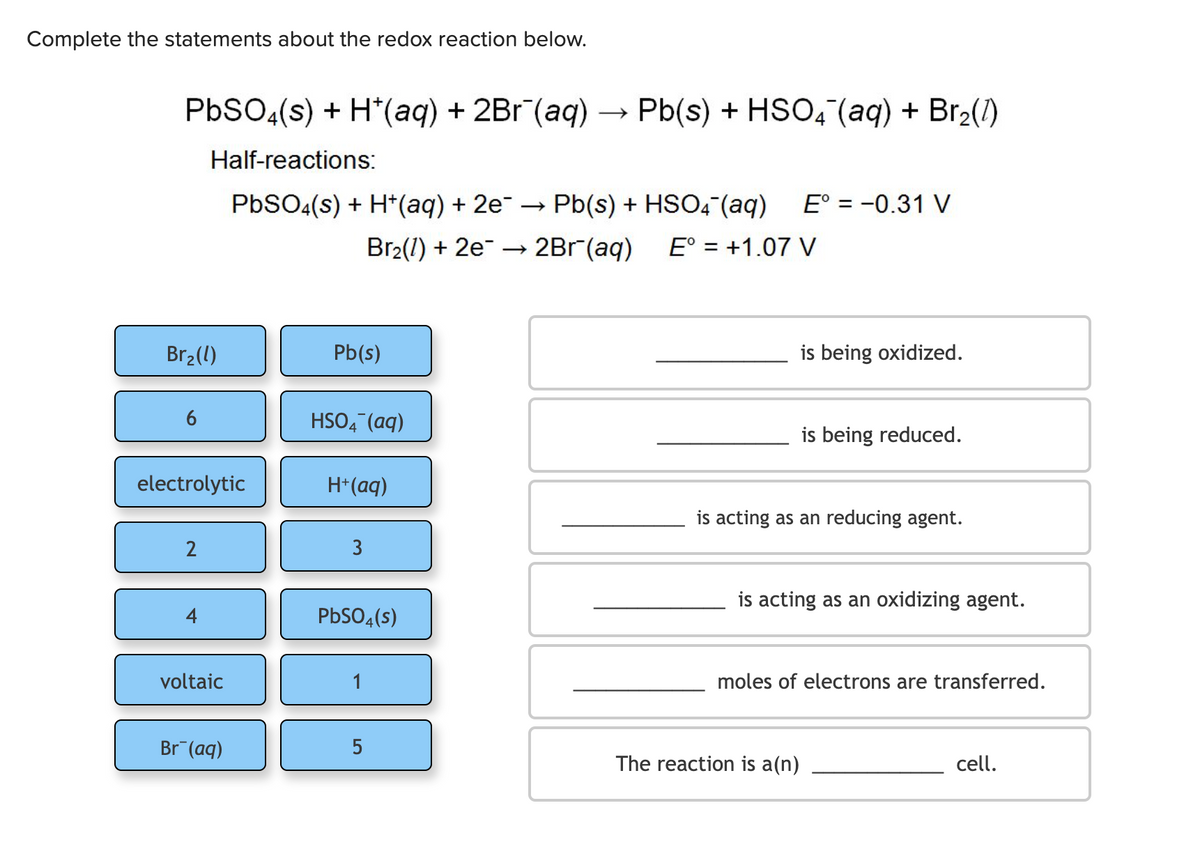Complete the statements about the redox reaction below. PbSO,(s) + H*(aq) + 2Br (aq) - Pb(s) + HSO, (aq) + Br2(1) Half-reactions: Pb(s) + HSO4"(aq) → 2Br(aq) PBSO4(s) + H*(aq) + 2e- E° = -0.31 V Br2(1) + 2e- → E° = +1.07 V Br2(1) Pb(s) is being oxidized. 6 HSO,"(aq) is being reduced. electrolytic H*(aq) is acting as an reducing agent. 3 is acting as an oxidizing agent. 4 PBSO4(s) voltaic moles of electrons are transferred. Br (aq) The reaction is a(n) cell.
Complete the statements about the redox reaction below. PbSO,(s) + H*(aq) + 2Br (aq) - Pb(s) + HSO, (aq) + Br2(1) Half-reactions: Pb(s) + HSO4"(aq) → 2Br(aq) PBSO4(s) + H*(aq) + 2e- E° = -0.31 V Br2(1) + 2e- → E° = +1.07 V Br2(1) Pb(s) is being oxidized. 6 HSO,"(aq) is being reduced. electrolytic H*(aq) is acting as an reducing agent. 3 is acting as an oxidizing agent. 4 PBSO4(s) voltaic moles of electrons are transferred. Br (aq) The reaction is a(n) cell.
Chemistry: An Atoms First Approach
2nd Edition
ISBN:9781305079243
Author:Steven S. Zumdahl, Susan A. Zumdahl
Publisher:Steven S. Zumdahl, Susan A. Zumdahl
Chapter17: Electrochemistry
Section: Chapter Questions
Problem 135CWP: Consider a galvanic cell based on the following half-reactions: a. What is the expected cell...
Related questions
Question

Transcribed Image Text:Complete the statements about the redox reaction below.
PbSO,(s) + H*(aq) + 2Br (aq)
Pb(s) + HSO, (aq) + Br2(1)
Half-reactions:
PbSO4(s) + H*(aq) + 2e-
Pb(s) + HSO4 (aq)
E° = -0.31 V
→
%3D
Br2(1) + 2e →
2Br (aq)
E° = +1.07 V
Br2(1)
Pb(s)
is being oxidized.
6
HSO4 (aq)
is being reduced.
electrolytic
H*(aq)
is acting as an reducing agent.
2
3
is acting as an oxidizing agent.
4
PBSO4(s)
voltaic
1
moles of electrons are transferred.
Br (aq)
5
The reaction is a(n)
cell.
Expert Solution
This question has been solved!
Explore an expertly crafted, step-by-step solution for a thorough understanding of key concepts.
This is a popular solution!
Trending now
This is a popular solution!
Step by step
Solved in 3 steps with 2 images

Knowledge Booster
Learn more about
Need a deep-dive on the concept behind this application? Look no further. Learn more about this topic, chemistry and related others by exploring similar questions and additional content below.Recommended textbooks for you

Chemistry: An Atoms First Approach
Chemistry
ISBN:
9781305079243
Author:
Steven S. Zumdahl, Susan A. Zumdahl
Publisher:
Cengage Learning

Chemistry
Chemistry
ISBN:
9781305957404
Author:
Steven S. Zumdahl, Susan A. Zumdahl, Donald J. DeCoste
Publisher:
Cengage Learning


Chemistry: An Atoms First Approach
Chemistry
ISBN:
9781305079243
Author:
Steven S. Zumdahl, Susan A. Zumdahl
Publisher:
Cengage Learning

Chemistry
Chemistry
ISBN:
9781305957404
Author:
Steven S. Zumdahl, Susan A. Zumdahl, Donald J. DeCoste
Publisher:
Cengage Learning


Chemistry: Principles and Practice
Chemistry
ISBN:
9780534420123
Author:
Daniel L. Reger, Scott R. Goode, David W. Ball, Edward Mercer
Publisher:
Cengage Learning

Chemistry: The Molecular Science
Chemistry
ISBN:
9781285199047
Author:
John W. Moore, Conrad L. Stanitski
Publisher:
Cengage Learning

Chemistry & Chemical Reactivity
Chemistry
ISBN:
9781133949640
Author:
John C. Kotz, Paul M. Treichel, John Townsend, David Treichel
Publisher:
Cengage Learning